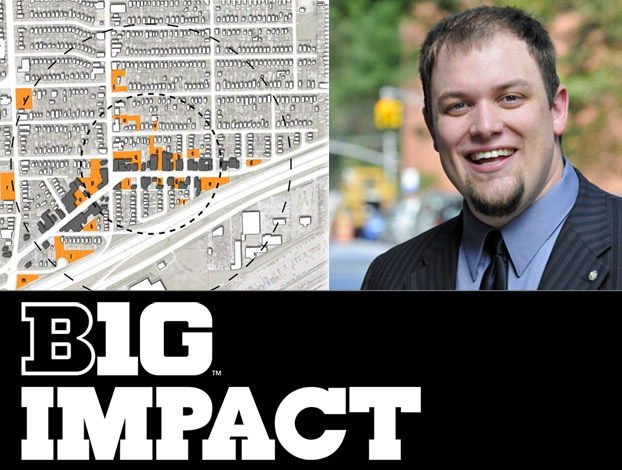
By Sarah Zwickle
Maybe it was the three years he spent in Neihardt residence hall that taught him that the secret of a tight-knit community is not just relational, but spatial.
Or maybe it was the rainy day in June when he and his future wife, Jill, jumped into the Broyhill Fountain that taught him how significant public spaces could be in a person’s life (oh, was I not supposed to mention that?).
Or maybe Wayne Mortensen, a native Nebraskan, my husband’s college roommate, and UNL graduate of 2003 was just born to design spaces where people live, work and play.
Three master’s degrees (architecture, urban design and social work) later, Mortensen could be working for just about any architecture firm in the country. Instead, he decided to apply for the Enterprise Rose Architectural Fellowship offered by Enterprise Community Partners – a national organization whose mission for the last 30 years has been to invest in affordable housing that didn’t just give people a roof over their heads but also was designed in a way that created real opportunities for people of low and moderate income to flourish.
Out of the approximately 250 applicants for the fellowship in 2010, only four were chosen nationwide – one of them was Mortensen. He chose to go to Cleveland and work with a community nonprofit called Neighborhood Progress Inc. or NPI.
FINDING, BUILDING COMMUNITY IN CLEVELAND
Why would a Nebraskan find a struggling city like Cleveland such an exciting place to live and work? Not since living in small town Nebraska, Mortensen said has he encountered citizens that are so engaged and invested in their communities.
He was tired of just planning and leaving the implementation to others. He wanted to see how his work, and the work of others in his organization, would impact lives. Architecture and urban planning, Mortensen stressed, is not about buildings; it’s about people.
As part of his job, Mortensen acts as liaison for an intriguing social process to build not just the physical infrastructure of affordable housing but the social infrastructure of significant community engagement and prosperity.
Mortensen works for and on behalf of the residents of as many as 15 different neighborhoods, engaging local residents to feel empowered to define their own futures in the way that their living spaces are designed. Every person’s idea is listened to and, if possible, incorporated into community plans.
BALANCING NEEDS, SPACE AND TIME
Mortensen is integral to this public process.
Plans are put before the people and made approachable. They are encouraged to articulate, write and even draw their ideas directly onto the plan. Such an honest and genuine relationship between designers, builders and the community is neither quick nor easy.
All great ideas take time and resources to implement, and not all great ideas may be possible. For example, Mortensen said that almost every neighborhood wants a grocery store. Unfortunately, market research makes grocery store chains reluctant to build in some neighborhoods. Instead, NPI tries to engage local co-ops and farmers markets to bring fresh food to lower income areas.
Neighborhood Progress Inc. has several initiatives, but two of the most visible projects work to fill in Cleveland’s empty spaces.
The first one is “Re-imagining Cleveland” – a community based process to deal creatively with the more than 3,500 acres of vacant lots. Seeing the opportunity for low-income neighborhoods to have access to fresh, local food, NPI is working with urban agricultural programs to turn those empty lots into farms.
The second initiative is to stabilize neighborhoods by taking care of more than 19,000 vacant and abandoned homes, which reduce property values, increase crime and damage real estate values. Mortensen’s group rehabilitates, demolishes, or “mothballs” (seals up the house from outside elements) the homes in order to maintain market stability. A lot of places in Cleveland, Mortensen said, have good “fabric” and potential for beauty and vibrant common spaces.
ARCHITECTURE – A STORY OF GETTING INVOLVED
Mortensen was influenced during his time at UNL when he joined the American Institute of Architecture Students (AIAS) as a freshman. By the time he was a junior, Mortensen was the president of the Nebraska chapter of AIAS.
After his senior year, he became president at the national level and initiated Freedom By Design (FBD). FBD trains architecture students to address common obstacles of low-income, recently disabled people through the medium of design. This year, Mortensen will chair the 12th session of the American Institute of Architects’ (AIA) National Associates Committee (NAC), which represents emerging architects and non-licensure track professionals.
As president of AIAS, Mortensen visited nearly 40 different schools of architecture across the country. These visits, combined with his national involvement, gave him a sense of empowerment.
Architecture, Mortensen said, was a steerable profession that could be navigated, like a slow moving ship, toward more equitable and just societal grounds. Architecture could have a role in housing forfeited by people long ago, by re-constructing houses and places that valued the community and invested in people, not just buildings.
One of Mortensen’s colleagues refers to him as an architect of communities. Mortensen explained that his work in Cleveland keeps his hope alive that communities will be just, vibrant, diverse and thriving in the future – even though change may be slow and difficult.
Slow is good. It keeps architectural design at the pace of people’s lives rather than at the pace of suburban sprawl and housing bubbles that burst. His fellowship, Mortensen said, is a great venue to practice his vision for community and beauty.
At a time when many people have lost hope of ever finding a job or owning their own home again, it is good to know that UNL played a central role in cultivating Wayne Mortensen’s career as an architect of communities.